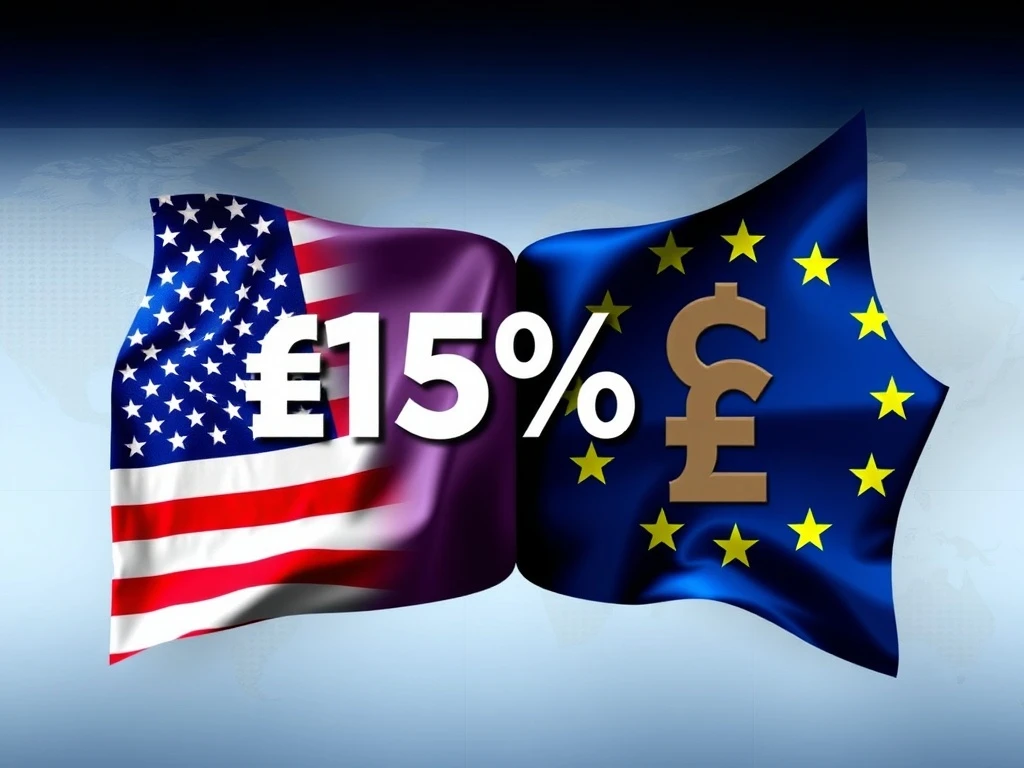US-EU Trade Pact: Trump Hails Landmark $1.35T Deal with 15% Tariff

In the dynamic world of global finance, macroeconomic shifts can send ripples across every market, including the often-volatile cryptocurrency space. While crypto markets operate on their own unique dynamics, major international agreements and policy changes frequently influence investor sentiment and capital flows. A recent development that has captured global attention is the significant US-EU trade pact, a landmark agreement announced by U.S. President Donald Trump, which introduces a 15% tariff and involves massive investments. Let’s dive into the details of this historic deal and explore its potential ramifications.
US-EU Trade Pact Unveiled: A New Era for Transatlantic Commerce?
On July 26, 2025, a pivotal moment in international trade unfolded as U.S. President Donald Trump announced a comprehensive trade agreement with the European Union. This wasn’t just another negotiation; it was touted as “the biggest deal ever made,” signaling a new chapter for transatlantic economic relations. The core components of this monumental US-EU trade pact include:
- Total Value: A staggering $1.35 trillion, making it one of the largest bilateral agreements in history.
- Tariff Implementation: A 15% tariff imposed on EU exports to the U.S. This consistent rate reflects a strategic shift in U.S. trade policy, aligning with recent agreements with nations like Japan, Vietnam, and Indonesia.
- EU Investment Pledge: The European Union committed to a substantial $600 billion investment into critical U.S. energy and defense sectors. This aims to bolster American industrial growth and strategic capabilities.
- American Equipment Purchase: Complementing the investment, the EU also agreed to a $750 billion purchase of American energy and military equipment.
This agreement, finalized just ahead of an August 1 deadline, was crucial in averting a potential full-blown trade war, opting instead for a reciprocal framework that replaced earlier, more aggressive proposals. It aims to stabilize trade relations and foster mutual economic growth.
Understanding the 15% Tariff: Reciprocity in Action
The introduction of a 15% tariff on EU exports to the U.S. is a cornerstone of this new agreement. European Commission President Ursula von der Leyen confirmed that this rate would apply universally, with specific exceptions for “zero for zero tariffs” on strategic goods such as aircraft parts and certain minerals. This flexibility, she emphasized, is vital for preserving competitiveness within key European industries.
U.S. negotiators, on their part, highlighted the EU’s commitment to opening its markets to American goods at 0% rates, emphasizing the reciprocal nature of the deal. This approach, as Treasury Secretary Scott Bessent noted, is consistent with the administration’s strategy of “making the best deal first” to establish clear tariff benchmarks across various trade partners. The consistent 15% rate across recent U.S. bilateral deals signals a deliberate and calculated shift in American trade policy, moving away from broad multilateral negotiations towards more tailored, reciprocal frameworks.
Trump Trade Deal: A Strategic Recalibration of U.S. Priorities?
This latest Trump trade deal marks the sixth major trade agreement under his administration, following significant pacts with countries like Vietnam, Japan, and the UK. This pattern underscores a clear trend: a prioritization of bilateral frameworks designed to align with specific U.S. economic priorities, often emphasizing domestic industrial growth and reciprocal market access.
President Trump’s characterization of the agreement as “the biggest deal ever made” reflects his administration’s focus on securing tangible economic benefits and stabilizing transatlantic trade relations. The EU’s investment pledge, specifically targeting U.S. energy production and defense manufacturing, directly aligns with this focus on strengthening domestic industries and job creation. This strategic recalibration aims to ensure that future trade relationships are built on balanced commitments, reducing past imbalances and fostering a more equitable global trading environment.
Global Trade Agreement: Navigating Repercussions and Reactions
As with any monumental global trade agreement, reactions have been varied. European leaders have expressed cautious optimism, acknowledging the deal’s potential to avert a larger trade conflict while also recognizing the internal debates it may spark regarding its impact on sensitive industries within the EU. The agreement’s success hinges on its implementation and the ability of various sectors to adjust to the new tariff landscape.
U.S. officials are optimistic that the deal will significantly reduce business uncertainty, providing a more predictable environment for companies operating across the Atlantic. However, analysts caution that the true long-term success of the agreement will only become clear as markets adapt and the full scope of its economic implications unfolds. The complexity of integrating such a significant shift into existing supply chains and market structures will undoubtedly present both opportunities and challenges.
Economic Impact: What Does This Mean for Global Markets?
The immediate economic impact of the US-EU trade pact is expected to be multifaceted. The substantial investments in U.S. energy and defense sectors could stimulate significant growth in these industries, potentially creating jobs and boosting manufacturing output. For the EU, the reciprocal zero-tariff access to American markets for strategic goods could help maintain competitiveness in key sectors.
More broadly, a stabilized transatlantic trade relationship could contribute to greater global economic predictability. While direct impacts on cryptocurrency markets are indirect, a more stable global economic environment, characterized by reduced trade tensions, often fosters greater investor confidence across all asset classes. Conversely, any unforeseen challenges in the deal’s implementation or negative market adjustments could introduce new uncertainties. This pact is a clear signal of evolving global economic dynamics, reminding us that interconnectedness means shifts in one major sector can create ripple effects everywhere.
Conclusion: A Bold Step in Global Trade
The US-EU $1.35 trillion trade pact, featuring a 15% tariff and substantial reciprocal commitments, represents a bold and strategic move in global trade relations. Hailed by President Trump as “the biggest deal ever,” it aims to stabilize transatlantic commerce, bolster U.S. economic interests through significant investments, and set new benchmarks for bilateral agreements. While the immediate reactions are mixed, the agreement’s potential to reduce uncertainty and foster a more reciprocal trading environment is clear. Its long-term success will depend on careful implementation and the adaptability of global markets, but one thing is certain: this deal will shape the future of international trade for years to come.
Frequently Asked Questions (FAQs)
Q1: What is the primary purpose of the new US-EU trade pact?
The primary purpose of the US-EU trade pact is to stabilize transatlantic trade relations, avert a potential trade war, and bolster U.S. economic interests through reciprocal commitments, including significant investments and purchases from the EU.
Q2: What is the significance of the 15% tariff in this agreement?
The 15% tariff on EU exports to the U.S. is a key component, consistent with recent U.S. bilateral agreements. It marks a strategic shift towards reciprocal trade, where the EU also commits to 0% tariffs on certain American goods, aiming for a more balanced trade relationship.
Q3: How much investment and purchases are involved from the EU side?
The EU has committed to a $600 billion investment into U.S. energy and defense sectors, alongside a $750 billion purchase of American energy and military equipment, totaling $1.35 trillion in economic activity.
Q4: How does this deal compare to previous U.S. trade agreements?
This is the sixth major trade deal under the Trump administration, emphasizing a trend towards bilateral frameworks over multilateral negotiations. It prioritizes U.S. economic interests and aims for reciprocal commitments, setting a consistent 15% tariff benchmark seen in other recent agreements.
Q5: What are the potential economic impacts of this trade pact?
The potential economic impacts include strengthened U.S. energy production and defense manufacturing, reduced business uncertainty for companies, and a more stable global economic environment. However, analysts note that long-term success will depend on implementation and market adjustments.









